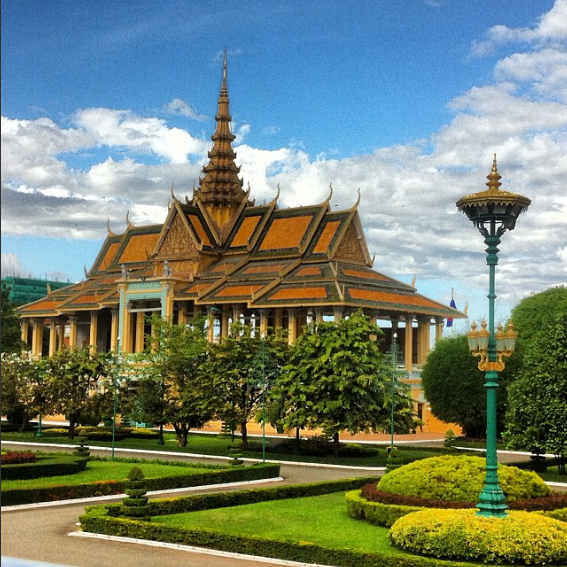The Royal Palace of Cambodia: No words can express the heart-breaking beauty of Cambodia’s Royal Palace, which is similar to priceless Cambodian gold. So, why not go to Cambodia and see the true grandeur of this unique Palace? It’s time to pack your belongings, schedule a tour, and go on the most exciting experience with your loved ones!
The Royal Palace is home to several impressive structures. The Throne Hall, located to the left of the main entrance, is one of the most important. It has a 59-meter-tall observation tower. The roof of the tower is stunning, with ornate tiers of golden-colored tiles adorning the structure. This tower holds high-level formal festivities, coronations, and audiences with foreign dignitaries and government officials. In 1866, His Majesty Preah Bat Norodom, the great grandfather of our present King, began construction on the palace complex. The Royal Palace is constructed on the location of the former town center. According to a Commission of Royal Ministers and Astrologers, this location got explicitly chosen for its great geographical symbolism concerning the King. He was regarded as a direct descendant of the gods and was tasked with living and ruling on earth while under the influence of heaven.
Dress code for visiting- The Royal Palace of Cambodia
Visits to the Palace’s Silver Pagoda and its surrounding area are the only permitted activities. The use of photography is, however, strictly prohibited inside the pagoda. Visitors are required to dress in shorts that extend to the knees and T-shirts or blouses that reach to the elbows; otherwise, they will need to rent a suitable covering from the concessionaire. It is particularly crowded at the Palace on Sundays when Khmers from the countryside pay their respects. However, it is a fun way to explore the area, which is thronging with locals.
The layout-The Royal Palace of Cambodia

The construction of the King’s home began in the 1930s. If the royal blue flag is flying, it indicates that he is currently in residence. You may find the royal guesthouse on the far right of the picture. His mother relocated to this building after the death of former king Sihanouk’s father, who had lived at the royal mansion. Today, it serves as a hostel for royal visitors and other distinguished guests.
You may see another modest structure to the left of the royal hall. One of the basement features is a fair dress display, which includes replicas of the outfits that Sihamoni was wearing during his coronation.
The strangest tower on the road to the Silver Pagoda is behind and to the left of this structure: a grey, largely cast-iron gift from France initially built in Egypt and now stands in the middle of the path. It was given to Cambodia by Napolean III in 1876 as a thank you gift.
The Gates-The Royal Palace of Cambodia
There are four gates to the Royal Palace. The eastern Victory Gate, which goes straight to the entrance of the throne hall, is reserved for royals and other VIPs to enter the Palace. The northern gate, also known as the funeral gate, is only opened once a king has passed away. A one-kilogram solid gold mask concealing the face of the monarch’s corpse got placed on it, and it is held in state at the Palace for three months before being exhumed and brought out through this gate. The west gate, also known as the execution gate, was utilized by condemned prisoners leaving the Palace to be executed. The southern entrance is designated for commoners, and it is via this gate that the general public may get access to the Silver Pagoda complex.
Take note of the four pale, almost clown-like faces that adorn the Palace’s throne hall ceiling, which depict the all-seeing King. While the walls of the hall got painted bright yellow, symbolizing Buddhism, and white, representing Hinduism, the two principal religions of Cambodia until they were united into one by Jayavarman VII in the 12th century, the hall itself is painted bright yellow, symbolizing Buddhism. It is only for royalty and VIPs that the center door of the five gates at the entrance of the throne hall is opened. Take notice of the Ramayana ceiling painting, painted in 1913, and you can find it on the second floor. The thick carpet delivered by China in 1993 is a perfect complement for the lotus-bud floor tiles on the ground floor.
Silver Pagoda
Silver Pagoda is found on the south side of the royal grounds; the Silver Pagoda is a compound with several buildings. In the center of the complex lies a royal temple which is generally known as Wat Preah Keo. Like gold and jeweled Buddha sculptures, many national treasures are housed in the main building’s main hall. A tiny crystal Buddha (the “Emerald Buddha” of Cambodia) is unknown whether it was made of Baccarat Crystal or another crystal in the 17th century. A near-life-size Maitreya Buddha encrusted with diamonds dressed in royal regalia, both commissioned by King Sisowath – are among the most notable pieces on display. During King Sihanouk’s reign before his assassination in 1979, the Silver Pagoda had more than 5,000 silver tiles, and portions of its outside face got remodeled with Italian marble.
In addition to the main building or the Vihear, there are several structures in the immediate vicinity. The statue of King Norodom, who rides a white horse, is found to the east. The library is situated to the north of the Vihear. The bell tower is located in the northwestern corner, while the model of Angkor Wat is located to the south of it. Four structures can be found south of the Vihear, arranged from west to east: the Phnom Mondop, which houses the statue of Preah Ko, the Chedi of Princess Kantha Bopha, the Dharmasala, and the Chedi of H.M. King Suramarit and Queen Kossamak. The Phnom Mondop is located south of the Vihear, and The artwork of the epic saga of Reamker covers the wall surrounding the structures. However, because of a lack of maintenance, the bottom half of the mural has faded over the years.
Moonlight Pavilion-The Royal Palace of Cambodia
This open-air pavilion, known in Khmer as the Preah Tineang Chan Chhaya (Khmer: ), or “Moonlight Pavilion,” has hosted performances of Khmer classical dance in the past and present. It is one of the most remarkable buildings within the Palace since it is visible from the outside because it got constructed across a piece of the palace walls. On the second floor of the Chan Chhaya Pavilion is a balcony once utilized as an observation platform for parades going along Sothearos Boulevard in Phnom Penh.
The current pavilion is the second pavilion. The first was constructed in 1913–14 as a replacement for the earlier wooden gazebo. Similar in design to the previous pavilion, the present structure got erected in the exact location. Located on Sothearos Boulevard, the Chanchhaya Pavilion is a prominent feature of the Palace’s architecture. The pavilion provides a site for the Royal Dancers, a tribune from which the King addresses the public and a location for state dinners and royal banquets. The pavilion was most recently utilized for dinner and as a tribune for the new King during King Norodom Sihamoni’s coronation in 2004.
Throne Hall-The Royal Palace of Cambodia
It was here that the King’s closest confidants, royal officials, and military leaders used to carry out their responsibilities. As a venue for royal (such as royal marriages and coronations) and religious rituals, as well as a gathering area for the King’s guests, it is still in use today.
The three spires that cap the cross-shaped structure are a nice touch. The four-faced, white head of Brahma crowns the central spire, which rises to 59 meters. The Throne Hall has three monarchal thrones (one of which is more western in form, while the remaining two are more traditional in style) and golden busts of Cambodian queens and kings dating back to the era of King Ang Doung. The Throne Hall that stands on this location is the following constructed on this place. The first was built between 1869 and 1870 during the reign of King Norodom. In 1915, the Throne Hall got dismantled to make way for a new building. In 1917, construction began on the current structure, which King Sisowath dedicated in 1919.
The Structure
The structure measures 30 x 60 meters. Like all of the other buildings and structures, The Throne Hall is best photoed at sunrise. It faces east. The Reamker’s exquisite ceiling frescoes and the thrones (Preah Thineang Bossabok higher up in rear and Reach Balaing in front ) should be noted when visiting. North of the thrones, there is a figure of His Majesty Sisowath Monivong, clutching the Royal Sword in his right hand. The statue, built of gold and depicts him in casual clothing, is a work of art. On the contrary, south of the thrones is a gold figure of King Sisowath, who is clad and draped in the Royal Regalia of Cambodia and is sitting on the Preah Tineang Bossbok (Preah Tineang Bossbok).
The old throne, also known as the Preah Tineang Bossbok, is an antique nine-tiered throne in the classical Khmer design. On the coronation day, each Khmer King must be sat on it while attiring the Royal Regalia. There are two layers of miniature Garudas statues on the top, which elevate the upper portion of the bossabok, while on the bottom, there are delicate flower carvings throughout. The levels of hell, middle world, and the heavens are represented by three of the throne’s nine levels: heavens, middle earth, and hell. The Aphirom, four gold nine-tiered umbrellas, are placed around the bossabok to provide a protective barrier. After then, the bossabok is crowned with a white Royal Nine-tiered umbrella, which represents the King’s worldwide power.
The Throne
The throne sits facing the bossabok. There are two golden tea sets and one golden set of betel and areca nuts container sets on the table next to the Royal Throne, both parts of the regalia and are always present on the table, known as the Pean Preah Srei. An additional bossabok, known as the Preah Tineang Nearyrath Sophea, may be found behind the preach thineang bossabok. The preach thineang bossabok is reserved for the King, while the preach thineang Nearyrath Sophea is reserved for the queen.
Is it beautiful?-The Royal Palace of Cambodia
The Royal Palace, which is glistening with gold, is one of Phnom Penh’s most magnificent architectural achievements. It is the residence of His Majesty and Her Majesty and the Royal Family of Cambodia. In 1866, His Majesty Preah Bat Norodom, the great grandfather of our present King, began construction on the palace complex. The Royal Palace sits on the location of the former town center. According to a Commission of Astrologers and Royal Ministers, this site got explicitly chosen for its significant geographical meaning concerning the King, regarded as a direct descendant of the gods, and tasked with living and ruling on earth while under the influence of heaven. The Silver Pagoda and the Royal Palace are located next to each other on Sothearos Boulevard. While they are two independent structures, they are often treated as a single entity when tourists visit.
The takeaway
It is worth visiting the Royal Palace of Cambodia, which is a fine example of Khmer architecture. The complex gets separated into four main compounds by the walls that surround it. You can discover The Silver Pagoda on the south side, the Khemarin Palace on the north side, the Throne Hall is located in the center of the courtyard, and the private sector, also known as the Inner Court, is located on the west side. Many of the Palace’s structures are gradually constructed, and some were removed and reconstructed as recently as the 1960s. Some of the older structures date back to the nineteenth century. Even though the western courtyard is still privately owned, it is here that the monarch maintains his private residence, the Khemarin, in addition to the Villa Kantha Bopha, which serves as a guesthouse for foreign visitors.
Blog Posts
- Interesting Facts of Canada: Top 24
- Food Chains of the Tropical Rainforest
- Climate for Tropical Rainforest: All You Need to Know
- Birds from the Rainforest: 12 Spectacular Species
- Cheapest Countries for Travel: Top 25
- Traditional Foods of Colombia-Top 20
- Interesting Facts on Colombia-Top 20


